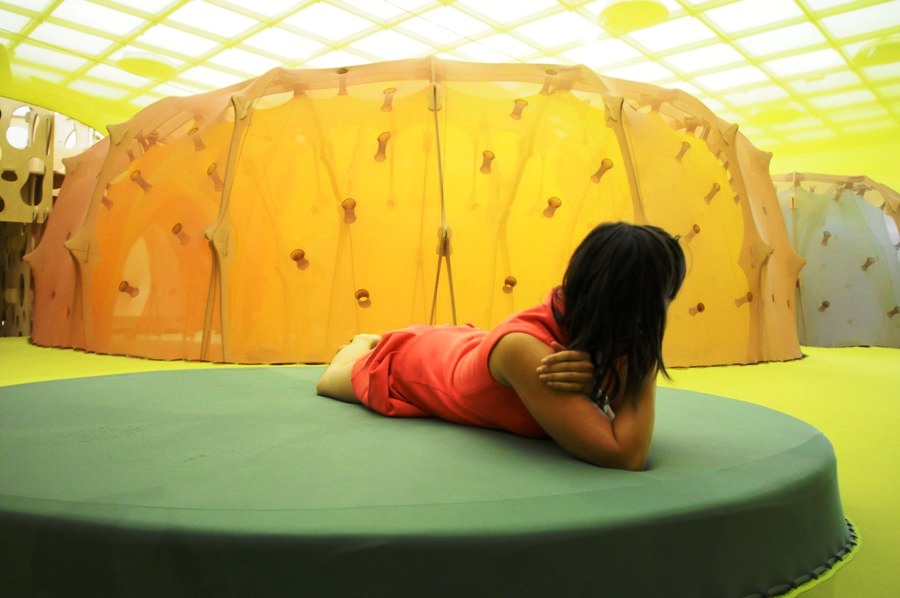The Hayward has been closed for the past six months for "housekeeping": those boring cleaning and repair jobs we all do. It's entirely suitable, therefore, that the two exhibitions that reopen the gallery showcase ideas of how we live both physically and emotionally. Ernesto Neto has become one of Brazil’s most successful exports, a powerhouse of an artist whose minimalist biomorphic shapes, created from stretchy, opaque nylon in sharply acid colours, alternately mould, mask, shade and reveal structures and forms. The Edges of the World is a vast installation across the entire top floor of the Hayward, continuing out onto the three (usually dreary) rooftop spaces.
A series of laser-cut wall-pieces, at first simply a spaghetti of lines, resolve themselves into a street-map, mimicking London’s spaghetti-plate of streets. From locating our bodies geographically, visitors proceed to locate our hearts: a large red-veiled pod pulses as, inside, you are invited to play the drums. Further along is a labyrinth of tunnel and pods, one section of which encourages the viewer to walk barefoot on its bouncy surface, to drop plushly into the installation as it leads outside, first to an almost parodically miniature park of a path and three trees neatly framed in a graffiti-strap of red nylon. The next exterior space is even more gloriously silly: a raised pool (main picture; installation: below right), complete with two changing-pods for the intrepid
 The shifts in mood and the resonances and depth they achieve are remarkable: the spirit is questioning but also serene. The perspectives are unstable, both literally, as the scale shifts and changes, the fabric conceals and reveals, and mentally – Neto’s little inserts stuffed with pebbles sometimes look like cave-paintings from Lascaux, sometimes smell elusively of spices, moving us from mankind’s first home to memories of our own homes.
The shifts in mood and the resonances and depth they achieve are remarkable: the spirit is questioning but also serene. The perspectives are unstable, both literally, as the scale shifts and changes, the fabric conceals and reveals, and mentally – Neto’s little inserts stuffed with pebbles sometimes look like cave-paintings from Lascaux, sometimes smell elusively of spices, moving us from mankind’s first home to memories of our own homes.
The New Décor, which spills across the ground floor rooms, as crowded and busy as Neto’s space is minimal, also explores our ideas of home, as 36 contemporary artists use interior design as their starting point. When does furniture stop being furniture and become art? And how does that change our views of them? "House" and "home" are not interchangeable words: "home" is an idea, not a place. As Richard Hamilton’s iconic 1956 collage so memorably asked, Just what is it that makes today’s homes so different, so appealing?
One of the stars of the show is Jin Shi’s 1/2 Life (pictured below left), where the artist creates a replica, half-sized, of the packing-crate living-space of a typical Chinese worker. It is both meagre and over-stuffed, filled with possessions that have value only to those who have nothing. The miniaturised house is half-concealed behind a staircase, and we peer in, the overclass that constantly overlooks. Similar in impact is Mona Hatoum’s Interior Landscape, a bleak room with a bare cot with pillow, a shopping bag and wire coat-hanger, and a chair. Only on examination does the shape of "home" become clear, etched into each item – a map of Palestine embroidered in the artist’s hair on the pillow, the springs of the bed not springs, but barbed wire, the bag made out of a sliced-up map of the country. The presence of absence is chillingly made real.
 Equally unnerving, if less politically charged, is Tatiana Trouvé’s installation, Untitled, where white, kitchen-like melamine surfaces have unidentified wires, disturbingly scorched at the sockets; a piece shaped like an Isokon donkey has a tattered leather throw over it with multiple straps, their sinister edges countered by cheerful-looking bells: someone, or something, lives here, and something has definitely happened, but what, and how, takes place only in our minds. Elmgreen & Dragset’s Boy Scout is installed in the gallery’s freight lift. Here the standard youth-hostel bunk beds are given instability with the top bunk flipped to face downwards: erotic mirror images, or looming overseer? The latter predominates in this metal cage, particularly enclosed as it is behind Urs Fischer’s Untitled (Door), a rustically heavy frame, out of place in this urban, institutional setting.
Equally unnerving, if less politically charged, is Tatiana Trouvé’s installation, Untitled, where white, kitchen-like melamine surfaces have unidentified wires, disturbingly scorched at the sockets; a piece shaped like an Isokon donkey has a tattered leather throw over it with multiple straps, their sinister edges countered by cheerful-looking bells: someone, or something, lives here, and something has definitely happened, but what, and how, takes place only in our minds. Elmgreen & Dragset’s Boy Scout is installed in the gallery’s freight lift. Here the standard youth-hostel bunk beds are given instability with the top bunk flipped to face downwards: erotic mirror images, or looming overseer? The latter predominates in this metal cage, particularly enclosed as it is behind Urs Fischer’s Untitled (Door), a rustically heavy frame, out of place in this urban, institutional setting.
Yet the spirit of the show is not remotely depressing, livened as it is by pieces like Jim Lambie’s cheerily inviting Bed Head, a mattress covered with the glitter and fizz of thousands of buttons, and Roman Signer’s Floating Table, which does precisely that, an ordinary kitchen table held permanently above ground by a rush of compressed air underneath, both unnatural and yet entirely familiar. Similarly, Gelitin, the Austrian collective which has previously been shown so brilliantly at the Hayward with their rooftop boating-lake, contributes a series of pieces, including Dustbin, an ordinary red plastic bin that unnervingly stands its ground on legs made of articulated bones.
This widely disparate series of pieces has been given coherence and shape by expert curating, and the Hayward’s difficult spaces now prove the old adage: Home is where the (nylon-fabric-covered, drum-filled, beating) heart is.
 The shifts in mood and the resonances and depth they achieve are remarkable: the spirit is questioning but also serene. The perspectives are unstable, both literally, as the scale shifts and changes, the fabric conceals and reveals, and mentally – Neto’s little inserts stuffed with pebbles sometimes look like cave-paintings from Lascaux, sometimes smell elusively of spices, moving us from mankind’s first home to memories of our own homes.
The shifts in mood and the resonances and depth they achieve are remarkable: the spirit is questioning but also serene. The perspectives are unstable, both literally, as the scale shifts and changes, the fabric conceals and reveals, and mentally – Neto’s little inserts stuffed with pebbles sometimes look like cave-paintings from Lascaux, sometimes smell elusively of spices, moving us from mankind’s first home to memories of our own homes.The New Décor, which spills across the ground floor rooms, as crowded and busy as Neto’s space is minimal, also explores our ideas of home, as 36 contemporary artists use interior design as their starting point. When does furniture stop being furniture and become art? And how does that change our views of them? "House" and "home" are not interchangeable words: "home" is an idea, not a place. As Richard Hamilton’s iconic 1956 collage so memorably asked, Just what is it that makes today’s homes so different, so appealing?
One of the stars of the show is Jin Shi’s 1/2 Life (pictured below left), where the artist creates a replica, half-sized, of the packing-crate living-space of a typical Chinese worker. It is both meagre and over-stuffed, filled with possessions that have value only to those who have nothing. The miniaturised house is half-concealed behind a staircase, and we peer in, the overclass that constantly overlooks. Similar in impact is Mona Hatoum’s Interior Landscape, a bleak room with a bare cot with pillow, a shopping bag and wire coat-hanger, and a chair. Only on examination does the shape of "home" become clear, etched into each item – a map of Palestine embroidered in the artist’s hair on the pillow, the springs of the bed not springs, but barbed wire, the bag made out of a sliced-up map of the country. The presence of absence is chillingly made real.
 Equally unnerving, if less politically charged, is Tatiana Trouvé’s installation, Untitled, where white, kitchen-like melamine surfaces have unidentified wires, disturbingly scorched at the sockets; a piece shaped like an Isokon donkey has a tattered leather throw over it with multiple straps, their sinister edges countered by cheerful-looking bells: someone, or something, lives here, and something has definitely happened, but what, and how, takes place only in our minds. Elmgreen & Dragset’s Boy Scout is installed in the gallery’s freight lift. Here the standard youth-hostel bunk beds are given instability with the top bunk flipped to face downwards: erotic mirror images, or looming overseer? The latter predominates in this metal cage, particularly enclosed as it is behind Urs Fischer’s Untitled (Door), a rustically heavy frame, out of place in this urban, institutional setting.
Equally unnerving, if less politically charged, is Tatiana Trouvé’s installation, Untitled, where white, kitchen-like melamine surfaces have unidentified wires, disturbingly scorched at the sockets; a piece shaped like an Isokon donkey has a tattered leather throw over it with multiple straps, their sinister edges countered by cheerful-looking bells: someone, or something, lives here, and something has definitely happened, but what, and how, takes place only in our minds. Elmgreen & Dragset’s Boy Scout is installed in the gallery’s freight lift. Here the standard youth-hostel bunk beds are given instability with the top bunk flipped to face downwards: erotic mirror images, or looming overseer? The latter predominates in this metal cage, particularly enclosed as it is behind Urs Fischer’s Untitled (Door), a rustically heavy frame, out of place in this urban, institutional setting.Yet the spirit of the show is not remotely depressing, livened as it is by pieces like Jim Lambie’s cheerily inviting Bed Head, a mattress covered with the glitter and fizz of thousands of buttons, and Roman Signer’s Floating Table, which does precisely that, an ordinary kitchen table held permanently above ground by a rush of compressed air underneath, both unnatural and yet entirely familiar. Similarly, Gelitin, the Austrian collective which has previously been shown so brilliantly at the Hayward with their rooftop boating-lake, contributes a series of pieces, including Dustbin, an ordinary red plastic bin that unnervingly stands its ground on legs made of articulated bones.
This widely disparate series of pieces has been given coherence and shape by expert curating, and the Hayward’s difficult spaces now prove the old adage: Home is where the (nylon-fabric-covered, drum-filled, beating) heart is.
- Ernesto Neto: The Edges of the World and The New Décor at the Hayward Gallery until 5 September
- Admission to the pool is free but must be booked in advance by telephone: 0844 847 9910
- Check out Festival Brazil at the Southbank Centre









![SEX MONEY RACE RELIGION [2016] by Gilbert and George. Installation shot of Gilbert & George 21ST CENTURY PICTURES Hayward Gallery](/sites/default/files/styles/thumbnail_125_x_125_/public/mastimages/Gilbert%20%26%20George_%2021ST%20CENTURY%20PICTURES.%20SEX%20MONEY%20RACE%20RELIGION%20%5B2016%5D.%20Photo_%20Mark%20Blower.%20Courtesy%20of%20the%20Gilbert%20%26%20George%20and%20the%20Hayward%20Gallery._0.jpg?itok=3oW-Y84i)





Add comment